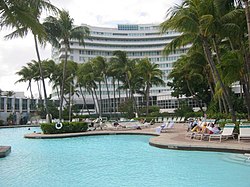Fontainebleau Miami Beach: Difference between revisions
No edit summary |
|||
| Line 34: | Line 34: | ||
In the 1970s a suite in the hotel is known to have been used by members of the [[Black Tuna Gang]] to run their operations. |
In the 1970s a suite in the hotel is known to have been used by members of the [[Black Tuna Gang]] to run their operations. |
||
The hotel closed a large part of its property in 2006, though one building remained open to hotel guests, and the furnishings were available for sale. The expanded hotel and its new condominium buildings |
The hotel closed a large part of its property in 2006, though one building remained open to hotel guests, and the furnishings were available for sale. The expanded hotel and its new condominium buildings re-opened in November of 2008.<ref>[http://www.fontainebleau.com/ Fontainebleau Hotel & Resort - Miami Beach, Florida - www.fontainebleau.com<!-- Bot generated title -->]</ref> |
||
=== Film history === |
=== Film history === |
||
Revision as of 15:27, 9 February 2009
Fontainebleau Hotel | |
 | |
| Location | Miami Beach, Florida, USA |
|---|---|
| Built | 1954 |
| Architect | Morris Lapidus |
| NRHP reference No. | 08001318[1] |
| Added to NRHP | December 22, 2008[1] |
The Fontainebleau Miami Beach or the Fontainebleau Hotel is one of the most historically and architecturally significant hotels on Miami Beach. Built in 1954 and designed by Morris Lapidus, it was considered the most luxurious hotel on Miami Beach at the time of its opening and for a long time after that, and is also thought to be the most significant building of Lapidus's career. The Fontainebleau Miami Beach is situated on oceanfront Collins Avenue in the heart of Millionaire's Row and is currently owned by Fontainebleau Resorts.
History
In his 1996 autobiography Too Much is Never Enough, Lapidus wrote that if: "American taste was being influenced by the greatest mass media of entertainment of that time, the movies.... So I designed a movie set!" The hotel was built by hotelier Ben Novak on the Firestone estate. Lapidus conceived of the ideas for the hotel each morning as he took a subway from Flatbush to his office in Manhattan.
The hotel is famous for its victory in the landmark 1959 Florida District Courts of Appeal decision, Fontainebleau Hotel Corp. v. Forty-Five Twenty-Five, Inc. 114 So. 2d 357, in which the Fontainebleau Hotel successfully appealed an injunction by the neighboring Eden Roc Hotel, to prevent construction of an expansion that blocked sunlight to the Eden Roc's swimming pool. The Court rejected the Eden Roc's claim to an easement allowing sunlight, in favor of affirming the Fontainebleau's vertical property rights to build on its land.[2][3]
In the 1970s a suite in the hotel is known to have been used by members of the Black Tuna Gang to run their operations.
The hotel closed a large part of its property in 2006, though one building remained open to hotel guests, and the furnishings were available for sale. The expanded hotel and its new condominium buildings re-opened in November of 2008.[4]
Film history
It was featured in the James Bond film Goldfinger, most notably in the sweeping aerial shot that follows the opening credits and accompanies composer John Barry's big-band track "Into Miami".
The swimming pool of the Fontainebleau was shown in Frank Sinatra's 1959 A Hole in the Head. Sinatra, Tony Manetta comes to a party for businessman and friend Keenan Wynn Jerry Marks.
The Fontainebleau was also the setting for Jerry Lewis's comedy film, The Bellboy. It gained a second round of architectural fame by its inclusion in critic and novelist Tom Wolfe's From Bauhaus to Our House, published in 1981, which referred to the condescending way that Lapidus was treated by the architectural profession and critics. The hotel, predominantly the pool area, was featured in the 1983 film Scarface. Other movies filmed there include Police Academy 5: Assignment Miami Beach, The Specialist and Bodyguard.
The hotel was also the location of the Bravo television network's show Top Chef in the third season.
The hotel was also used as the location for the Victoria's Secret Fashion Show 2008.
Renovations
The newly formed Fontainebleau Resorts purchased the complex in 2006 and rebuilt it over a two year period taking special care to preserve many of the original design elements including the famous "staircase to nowhere".
Lead by interior design firm Jeffrey Beers International, Fontainebleau now boasts 11 restaurants, a 40,000-square-foot (3,700 m2) spa, the bow-tie pool, and 1500 rooms.
La Côté is the two-level poolside bar and grille.
Other restaurants and nightclubs in the complex include:
- Gotham Steakhouse
- Scarpetta (Italian)
- Hakkasan (Cantonese)
- LIV (Nightclub, a.k.a. '54 formerly Tropigala Lounge)
- Blade (Sushi)
- Glow (Pool Bar)
On December 22, 2008, it was added to the U.S. National Register of Historic Places.[1]
References
- ^ a b c "Weekly List Of Actions Taken On Properties: 12/22/08 through 12/24/08". National Register of Historic Places. National Park Service. 2008-12-30.
- ^ FOUNTAINEBLEAU HOTEL CORP., a Florida corporation, and Charnofree Corporation, a Florida corporation, Appellants, v. FORTY-FIVE TWENTY-FIVE, INC., a Florida corporation, Appellee. @ LexisNexis Academic
- ^ Case @ University of Chicago
- ^ Fontainebleau Hotel & Resort - Miami Beach, Florida - www.fontainebleau.com

